Buying a live balled in burlap Christmas tree is a very special family event. When you buy a live Christmas tree as opposed to a cut Christmas tree you are buying a living thing that will be part of your family and part of your landscape for many years to come.
You pick out the tree as a family, you lug it home as a family (balled trees are heavy), you lug it into the house, you enjoy it for the holidays and then you lug it back outside and plant it in the yard.
As the years go on the tree grows and gets nicer and nicer each year. There is magic in this process because children have vivid memories and each of the steps of the process are firmly planted in their memory.
Plants Tell Stories.
As the tree grows so do the children right on into adulthood and those kids who grow to become adults always have a special place in their heart for that particular tree. For them it was a very special time in their life and just the site of or being near that tree trigger very fond memories of their childhood and the time of a much simpler, less stressful live. So as you consider what to do for a Christmas tree this year, think about the memories that your efforts are about to create.
Picking Out the Right Live Christmas Tree.
What do I need to know about picking out a nice tree? The process is quite simple. Pick a tree that you like, pick a tree that you can handle and buy your tree from a grower that has a passion for the trees that they sell. In other words, buy a tree that has been properly cared for on the tree lot. Balled trees have to be watered on a regular basis when sitting on top of the ground. A reputable grower will tend to that.
The other thing to be sure of is to make sure that the tree is not loose in the ball. Move the tree from side to side. As you do, the ball should move with the tree. If the tree moves and the ball stays stationary that’s a huge red flag. The ball must be tight and firmly affixed to the roots of the tree.
Think about this. We all like ice cream treats. You know the ones where they mix candy bars in with the ice cream and serve it to you in a cup with the spoon sticking in the ice cream right in the middle of the cup. Pretend that your Christmas tree is like that frozen treat. The cup of ice cream represents the tree ball and the spoon is the stem of the tree.
When they first hand it to you the ice cream is still cold and mostly frozen. If you set your ice cream treat on the table and move the spoon back and forth by the spoon the spoon is firm in the ice cream and as you rock it back and forth the cup tips with your movement as if the spoon is welded into the ice cream.
That’s what your Christmas tree should do. After a time the ice cream starts to melt and you can then move the spoon in the ice cream and the cup will remain stationary. I like my ice cream at that stage, but I don’t want a Christmas that can be moved around in the ball like that.
Got it? No more Ice Cream or other Yummy Food References!
It’s important that you dig the hole in the yard before you move the tree into this house. When you bring your Christmas tree home the ground might not be frozen so it’s important that you take advantage of workable soil because that may not be the case after Christmas. And . . . it’s important that you plant the tree as soon after Christmas as possible.
Planting Depth is Extremely Important.
Measure the tree for depth and width. After planting, the top of the root ball should actually be at least one inch, or two inches above the grade when you plant the tree. So that means that when you measure the height of the root ball you should subtract two inches from that number and dig the hole that deep. It’s important that the top of the root ball be at least one or two inches above grade because plants breathe through their roots. If you plant a tree too deep in the ground it will die because oxygen needs to pass through the soil to the root system.
Put the Soil You Remove from the Hole into a Wheelbarrow, Park the Wheelbarrow in the Garage so it doesn’t Freeze.
What? Yes. Fill your wheelbarrow with soil and park the wheelbarrow full of dirt in the garage so after Christmas you have soil to use for planting the tree that is not frozen. That’s why it’s important to dig the hole before Christmas, the weather changes a lot here in the north in a matter of days or hours.
Getting the tree into the house. Urrrrrrg!
Balled trees are heavy. In the nursery biz we often use a piece of burlap as a sling with one person on each side of the tree. We wrap the corner of the burlap around one hand, tip the tree backwards and slide the burlap sling under the rootball and lift. This divides the weight of the root ball in half so each person is only lifting half of the weight of the balled tree.
Once in the house place the root ball in a washtub. A what? Here, I Googled it for ya. You can buy a similar plastic tub at a discount store. As you place the root ball into the tub if you drop the ball slightly that should create a flat spot on the bottom of the ball so it sits flat. You can use wedges under the ball to make it straight if need be.
Water Be a Good Thing. But don’t Drown Your Tree.
Balled trees are living things, they need water to stay alive. Pour the water right over the top of the root ball slowly giving some of it a chance to soak in as it runs down over the ball. Some standing water in the bottom of the tub is fine, but no more than two inches. At first check the water twice a day to make sure it doesn’t all evaporate. Again when you add more water, pour the water over the root ball.
Be Kind to Your Living Tree.
Here’s the thing. You’ve opted for a living Christmas tree. Great idea! I commend you. But there is a bit of a trade-off. With a living tree, you cannot keep it in your house for weeks and weeks and weeks. It really only should be in the house for a short period of time. The less time it spends in the house the better for the tree. Here are a few things you should understand about a live Christmas tree.
1. This tree has been outside its entire life.
2. Just like an outside dog or a farm animal trees adapt and make internal changes before the next season arrives.
3. A Christmas tree is an evergreen. Come fall the needles start to harden off and get very rigid. They have to in order to survive the bitter cold of winter. My donkeys Get a Winter Coat, your Christmas hardens off for the winter.
4. Then it goes to sleep. It quits growing and goes into a rest period and it stays in that rest period until spring. They go completely dormant. That’s why a nurseryman can dig a balled tree and not put it into shock. Balled trees cannot safely be dug until they start to harden off for the winter. With plants timing is everything.
5. When you move the tree into your house for Christmas you are completely interrupting its natural cycle. The tree just went into dormancy and is quietly sleeping like an old bear. Then you come along and drag that bear into your living room. You crank up the heat and blast the Christmas music. What’s gonna happen? The bear is going to wake up!
6. In other words, I don’t think the Christmas music really has much of an effect on the tree, but the warm temperatures do. When the tree is suddenly surrounded by temperatures of 70 degrees F. what do you think is going to happen? The tree is going to think it’s spring and it will do what all trees do in the spring. It will start to put on new growth.
Bad, bad, bad! New Growth is Bad in the Dead of Winter.
7. Then when you take the tree outside after Christmas the cold air will destroy the new growth and throw the tree back into dormancy completely confusing the poor thing. It won’t know what season it is.
So, with all of that said you really only want the tree in the house for the shortest time possible. Two weeks is probably good, three weeks might be okay. Longer than that and you are really being selfish and not fair to the tree. Keep in mind, you bought a live tree, not a cut tree that is going to be put through a chipper when you are done with it.
The tree that you bought is going to be a friend for life. Treat it as such.
Okay, Christmas is over, what to do with the tree? Get it outside and plant it in the pre-dug hole immediately. You can leave the tree in your garage for a week or so, but make sure the root ball is moist and don’t leave it in your garage for more than ten days. Your garage is cooler than your house but almost as dry as your house. Plants are always happiest in the ground. Get your tree into the ground.
Now let’s say that while you were enjoying Christmas Mother Nature was throwing a tantrum outside snowing and blowing, freezing the ground. Should you still plant the tree outside?
Yes you should. If the hole that you dug is full of snow that’s fine. Just shovel the snow out and place the root ball into the hole. Check the grade. Make sure the root ball is at least one inch or two inches above the grade of the yard or bed where you are planting the tree. Take the dirt (soil!) that put in the garage and backfill around the root ball.
Do I need Peat Moss or some other Magic Potion from the Garden Center?
No. Peat moss is great for retaining moisture but evergreens really don’t like wet feet and unless you are in sand or gravel peat moss could do more harm than good. Now if you want to toss in some rotted (bagged) cow manure that would be fine.
Should I Fertilize My Tree Come Spring?
Only if you want to kill it. Evergreens are slow-growing and just cannot tolerate the amount of nitrogen in most fertilizers. That’s why I suggested the rotted cow manure. That will give the tree some nutrition without the chance of burning it up with too much nitrogen.
Once you have the tree in the hole you want to make sure that there are no nylon strings that might be wrapped around the stem of the tree. Sometimes growers lace the root ball with nursery twine to keep the tree stable in the root ball. Usually, the twine that they use is biodegradable sisal twine, but on occasion, they use a nylon twine that will never rot. Leaving the twine under and even around the root ball really won’t harm the tree, but if it’s wrapped around the stem of the tree that is not a good thing.
Should I remove the Burlap and the Wire Tree Basket?
No. If the burlap is a natural fiber burlap then it will rot quickly once the tree is planted and the new roots will push right through it. If the root ball is inside of a heavy wire tree basket you do not have to remove the wire basket. The holes in the wire basket are plenty open enough that the tree roots will easily grow through and around the wire basket.
Leaving the basket on really bothers some people, but trust me, the tree doesn’t mind and the basket will help to keep the tree stable as the winter winds beat on the top of the tree trying to rock it loose inside of the root ball.
If the burlap is a nylon type of artificial burlap you can still leave it on and I know a bunch of people are going to give me a ton of grief about this, but having installed tens of thousands of plants with these old worn out hands I know that the tree roots will find their way through that nylon burlap. If you want to take a knife and cut slits around the root ball that would be great. Be sure to loosen the nylon burlap from out the base of the tree so it can’t girdle the tree as the tree grows.
Be Certain to Stake the Tree after Planting.
Here’s the thing. It’s your tree, you can plant it however you want. But if you remove the tree basket and remove the burlap there’s a good chance that the tree ball is going to fall apart. Is that bad? Sorta, but not really. As long as you can plant the tree and certain that there are no air pockets around the exposed roots. If you leave the root ball fully intact, you won’t have exposed roots to worry about.
That’s why whenever possible I leave the root balls fully intact.
What’s bad is to not have the tree firmly in the ground. Once planted the tree really needs to be stable. Stake it with at least one stake so that as the wind blows the tree can’t rock back and forth. If the tree is allowed to rock back and forth it won’t be able to establish new roots into the ground because as soon as a root starts to anchor itself in the tree blows and the new root is broken.
Here’s a mini-course on tree staking if you need help with that.
A couple of things to keep in mind. Plants are the happiest in the ground. Even if the ground is frozen and you plant your tree in a frozen hole, there’s a good chance that once the tree is in the hole and backfilled, the soil around the root ball could actually thaw out. Especially if you get a few inches of snow cover. Snow is a great insulator so once your tree is planted a snowfall is the best thing for it.
Merry Christmas and Happy Holidays to those of you who don’t celebrate Christmas. More importantly, happy growing!
Questions, comments? Things to add to the story? Post them below.
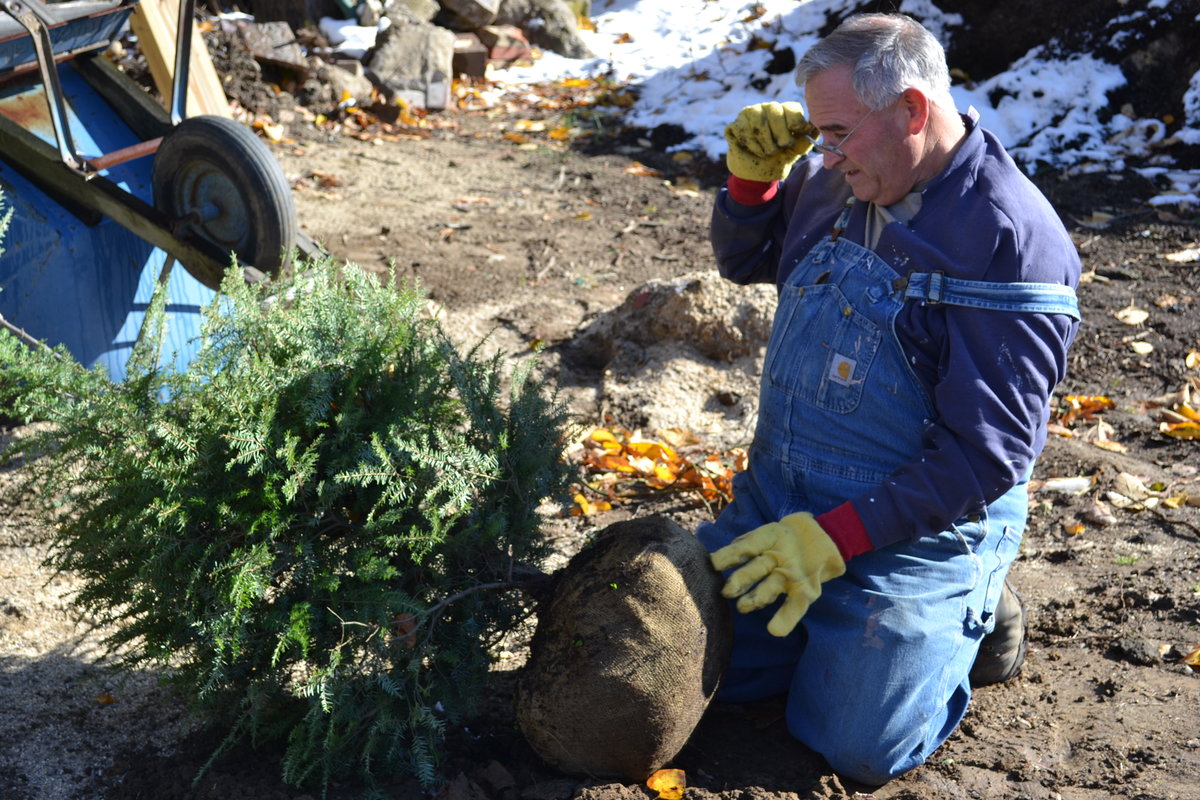
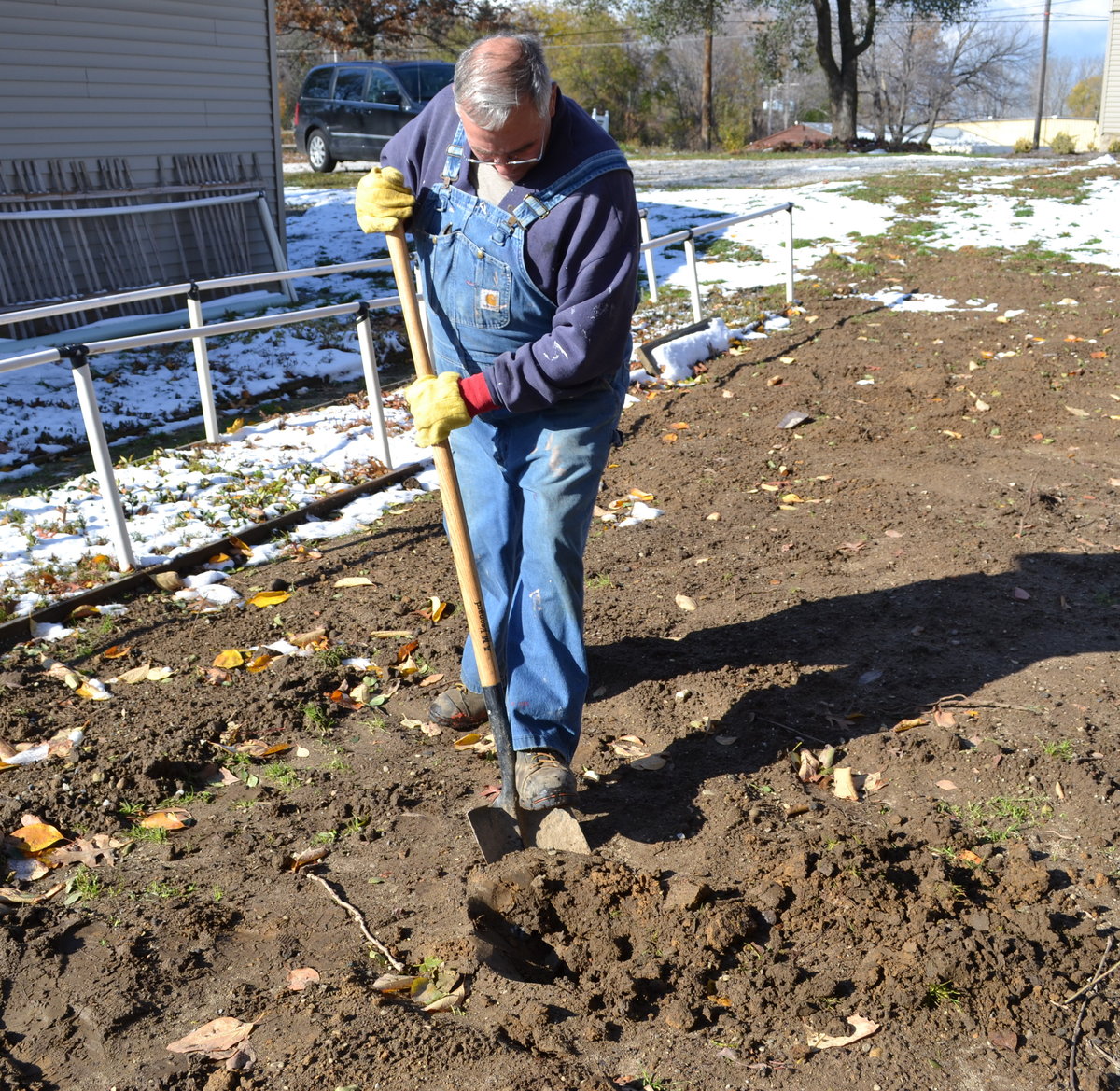
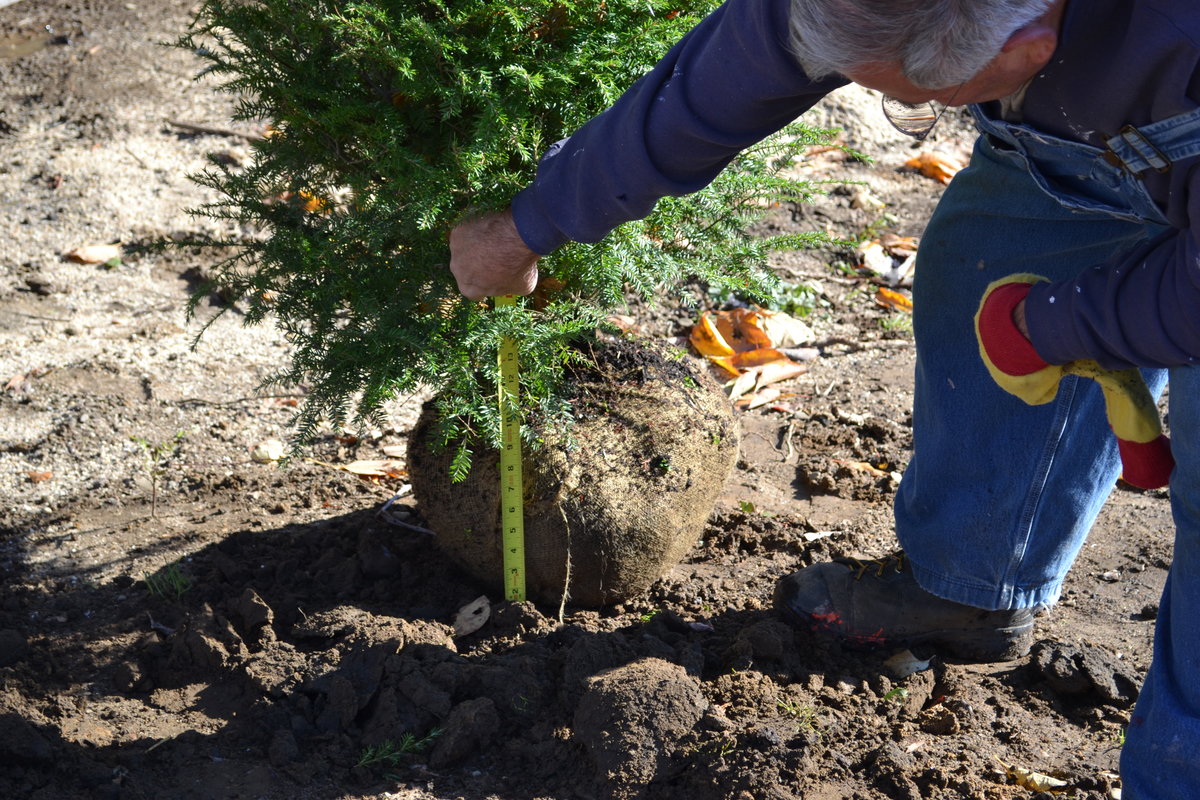
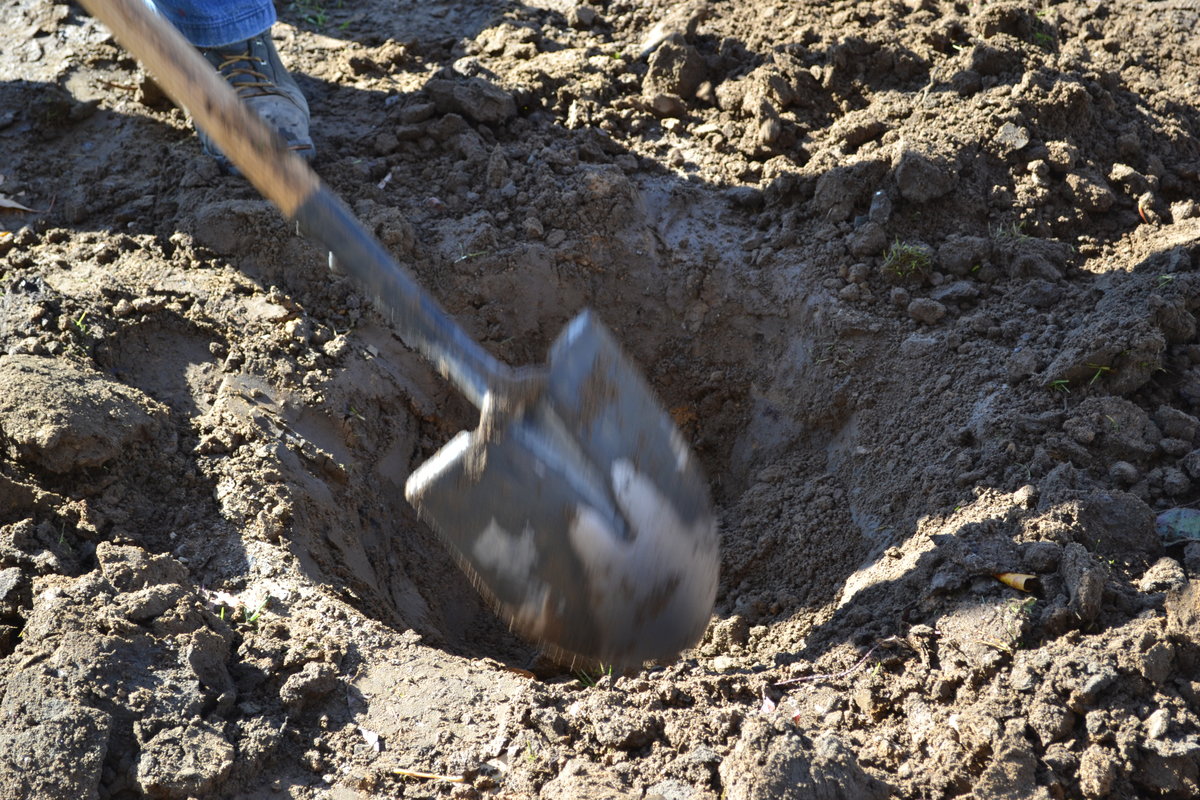
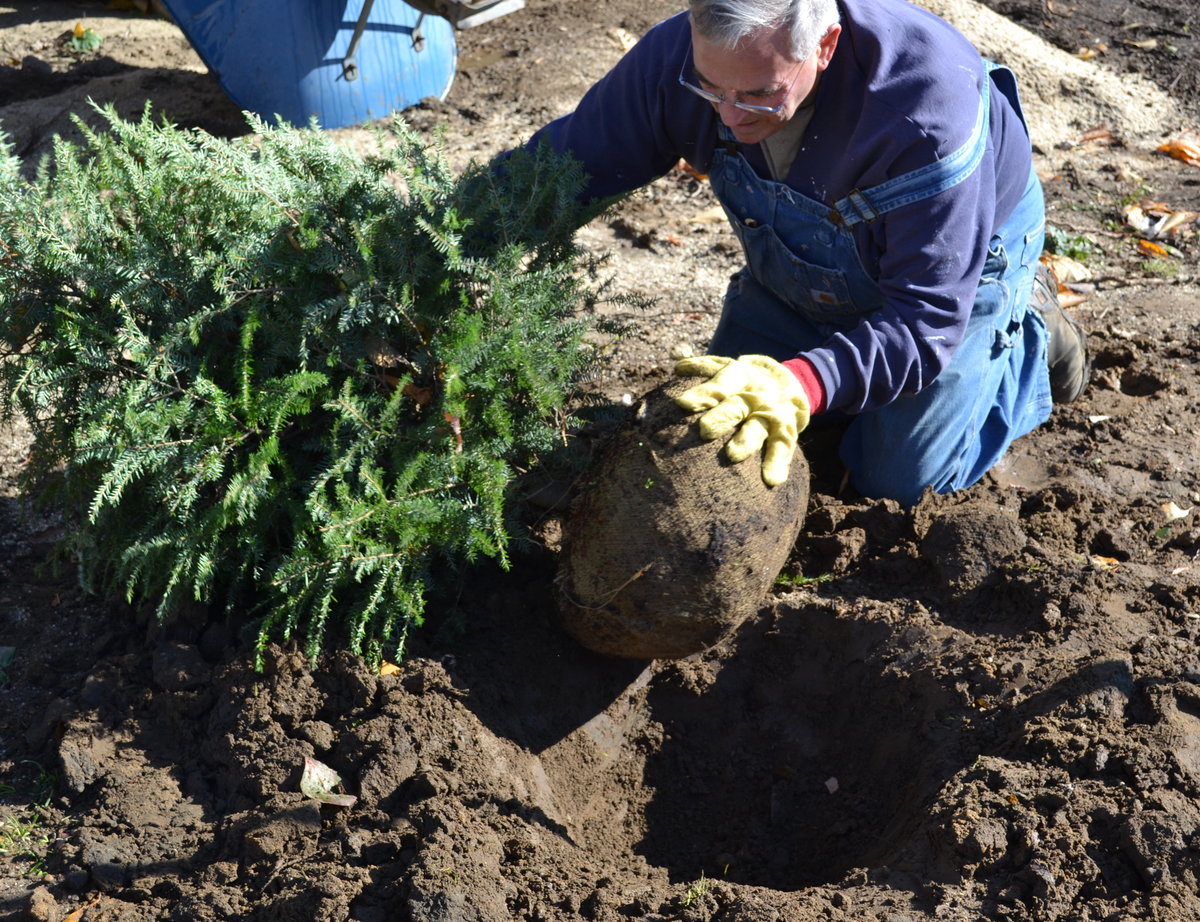
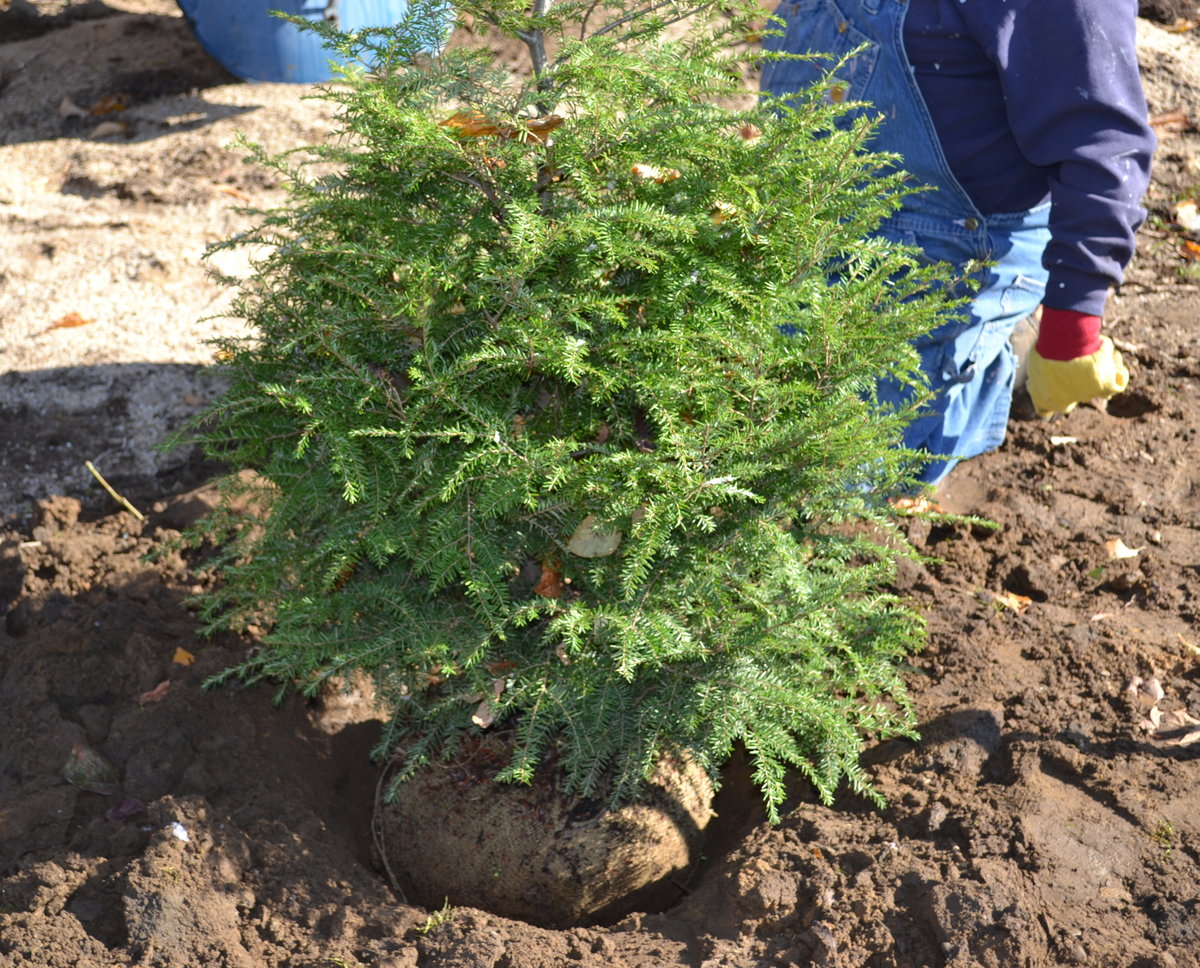
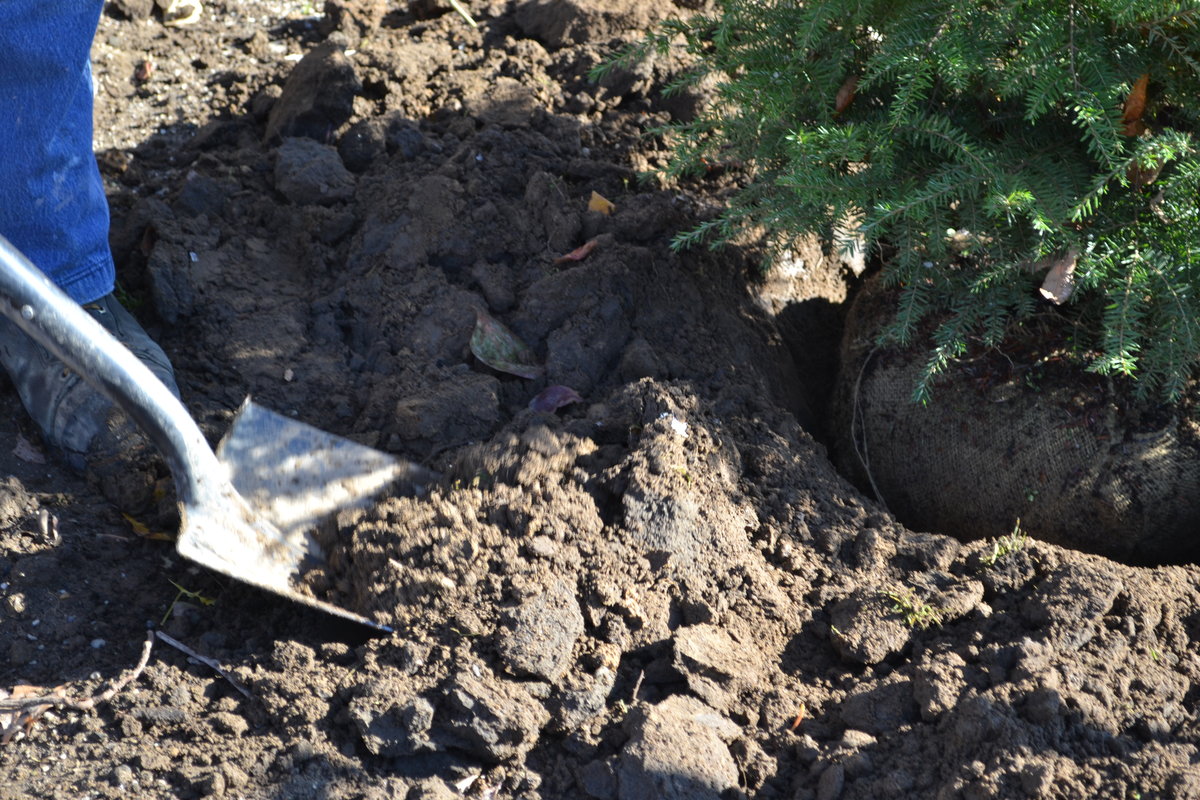
I had a spruce in a 10 gallon container that was growing outside for several years (zone 3). It was always watered in the summer, left alone in the winter, no mulch or protection. Last year we decided to bring it in for 2 weeks to be the Christmas tree. It did sprout new growth in that time, and was watered after the dirt thawed out. We transitioned it back outside in relatively mild weather (30’s), but by spring it was dead. What did we do wrong? Thanks!
Julie,
It’s really difficult to say, but just being in a container for 3 years would have already stressed quite a bit.
It woke up. Once the buds start to swell, it’s committed to growing. This is one of the problems with a live tree.
* If you got enough chilling in the fall, it will think that your warm house means ‘spring’ and will start to grow. The tips are no longer hardened for winter temps, and it won’t go dormant again until the days start getting shorter in late August.
Remedy: Keep it inside, and treat it like a houseplant until after last frost.
* If it didn’t get enough chilling in the fall, it thinks the warm spell is a February thaw. It will remain dormant.
This one you can put back outside. Put it in the garage for a few days, then into the hole if you have one, otherwise, park it in a snowbank on the north side of the house.
How can you tell:
Keep it inside for 3 weeks. If it’s going to wake up you will see it in this tim
***
Watering: You need a BIG saucer for the tree. Put a tray of ice cubes on it every day or so. They melt slowly and won’t make a mess. If they keep falling off the bag, put them in an onion bag.
Keep it away from heat registers.
Ideally keep the room cool — 60 is about right. A bright walkout basement window is perfect.
Merry Christmas to you, your family and staff! Looking forward to the NEXT home. With your helpful hints my wife and I have landscaped and sold four homes (we like to call them or four year flips!) Using your techniques we have noticed all the landscaping around those homes are doing very well. I am sure it helped the sale of them. The next place will be our retirement home in the heart of the Mitten. Looking forward to start a new landscaping theme all over again. It ain’t work when it’s what you love to do.
Thanks Jeffery, I appreciate that.
Merry Christmas
Mike, I love the idea of a living tree, but after a couple of decades I’d have a Christmas tree forest. If you pot a tree, bring it into the house briefly, and take it outside again, pruning judiciously as the years go by is it possible to maintain the potted tree for many Christmases to come? Thanks.
Teresa,
Probably not because most Christmas tree varieties grow too large too fast.
This post offers clear idea designed for the new people
of blogging, that genuinely how to do blogging and site-building.
how do I know how much, ,and how do I water my Christmas tree which is in a 50cm pot outside we bought it already in a smaller pot , the tree is a 4ft Norway spruce ,unfortunately we don’t have a garden to plant it in . Different sites tell you different ways your recommend way would be appreciated
thank you
Wendy,
if you intend to keep it in a pot, which I’m not crazy about, I’d buy a moisture meter so you know when it needs water. It’s easy to over water evergreen trees so you have to be careful. During the winter? Once a month at the most unless it’s warm. Spring summer and fall? Almost daily if the soil drains as it should.
Leaving the wire cage is concerning to me for two reasons. I was advised by my garden center to remove it on a river birch that I planted years ago but didn’t because I couldn’t get it off. I was also told by a landscaper that it would be hard on it (I don’t remember his exact words). A few years after planting it I was digging it up because the tree was always chlorotic throughout the growing seasons. I tried to fertilize but it didn’t help. The roots did find their way around the cage, of course, but they didn’t seem to be normally developed. I always figured the trouble was the cage being left on. Was this because of the variety of tree? Do some trees definitely need the cages removed? The other concern I have is that it seems some evergreens (like white pines) can grow very large and then just fall over, uprooted, in a bad snowstorm (this has happened in out back yard). If a cage was left on, wouldn’t this lack of root development be worse? The tree we have to plant now is a fraser fir, btw. We bought it for my friend’s mother for Christmas but she doesn’t want to bring it in at all and use it as a Christmas tree, but instead just have us plant it now so it will have a better chance of surviving. Thanks!!
Martha,
The openings in the wire cages are really large, roots have no problem finding their way out of the cages. Landscape contractors always leave the wire baskets on the trees they plant.
Mike, I hope you’ll understand a different experience with burlap. My extension university has found that burlap does not rot in the holes when it is left in place in our soils (these are intelligent people with advanced degrees, they know natural vs nylon burlap). So they recommend using the burlap to hold the soil ball intact but removing the top of the burlap by cutting it off if the ball is intact. This is based on the fact that they dug up several trees and the burlap underground after several years did not degrade at all.
Dana,
Basically you are saying what I mention in the article. Loosen the burlap around the base of the tree. But keep in mind, a truck load of advanced degrees cannot replace real world, hands on experience doing this stuff day in and day out for nearly 50 years. Regular, or even treated, natural burlap will rot when placed underground. If it does not, then the soil is way to dry to support a living tree.
A balled tree in treated, natural burlap, sitting on top of the ground, the bottom of the ball will be gone in less than 6 months. Probably three in wet conditions. When I say treated burlap I mean natural burlap that is treated with a fungicide type material to keep it from rotting so quickly.
I have found that even nylon burlap will not hold up for all that long when exposed to the sun. Underground I’m sure it will last a very long time. But I also know that the roots will find their way right through the nylon burlap into the soil. Again, it still has to be loosened around the trunk of the tree.
i use ice to ‘water’ my tree when inside.
Would just like to say a big thank you to mike for allowing me to link to this article from my own blog of our Christmas tree farm in Ireland http://limerickxmastreecentre.blogspot.ie/
Thanks Mike! Merry Christmas to you, Pam, Duston and all your family!
Hi mike can you do a video on how to sell and start christmas tress
If there is no snow when the Christmas tree is planted, should it be watered?
Mona,
Yes, water the tree at the time of planting.
I’ve been receiving your valuable newsletter for quite some time now. I presume that makes me ineligible for the Gardener’s Secret Handbook. So, is there some way you could make it available and what would the price be?
Thank you.
I planted a weeping redbud that was posted on craigs list , the landlord was going to destroy it. The bad thing is we couldn’t dig too deep into the ground beause of rocks and previous tree parts from a maple that was cut down. I did stake it. I really love this little guy and I want to know if the roots will grow sideways if they can’t get too deep. If I have to move it would the spring or the following fall be the best time to transplant it? I read that these guys don’t do well when transplanted. Please email the answer to me. Thanks!!!!!!!!!!!!!
Mary,
Chances are it will be okay, but it could dry out easily if not planted properly. If you decide to move it, do so before it gets leaves in the spring.
Do you water the tree when you first plant it, after Christmas? Where I live, MT, it snows some & often a week or more will go by without snow & without snow on the ground. Should the newly planted tree be watered from time to time if it doesn’t snow? Thanks, Blessings! & Merry Christmas : )
Elguard,
Watering it right after planting would be a good thing. After that I wouldn’t be concerned about it until it starts to get hot in the spring or summer.
In the beginning of your article you said planting depth is very important and that you should plant with at least 2 inches of the root ball above grade and then under your last picture you say “as you back fill around the root ball mound about 2” of soil over the top of the root ball??? I am a little confused, do you or don’t you cover the root ball?
Karen,
You do cover the root ball, but when you set the root ball in the hole the top of the root ball should be about 2″ above grade, then mound soil over the root ball.
My uncle bought the live tree and planted it following Christmas. I believe it was a Douglas Fir. It died. Is it possible that the warmth of the house can cause the tree to respond as if it were spring? Could the winter cold have killed it?
April,
A lot of things could have killed it. Keeping it in the house too long will trick the tree into thinking it’s spring. But more than likely the tree was planted too deep, possibly planted in a wet area, or the tree ball was loose which allows the tree to move around even after planting.
My uncle Jack had a wimpy Douglas Fir cut Christmas tree in a bucket of wet sand. After Christmas he took that tree out into the front yard and planted it – sort of a joke, because we all knew the thing could not grow. That baby sprouted roots and grew to be a monster!
Hi Mike,
What if I can’t dig a hole because the ground is already frozen?
Is there a way to take care of a live tree before it can be planted?
Thank you and Merry Christmas!
Edy,
If you can’t plant it right away then put it in a protected area outside and cover the root ball with lots of leaves or mulch until spring.
Thank you Mike, I will do this.
Also, I bought two arborvitae at a clearance/closeout
they are not in burlap but in plastic containers, can I do the same for these if I can’t plant them yet?
Thanks so very much, your awesome.
Edy
Thank you Mike. your ice cream analogy is memorable 🙂
Thanks for such a detaied guide to planting a balled up Christmas tree. These are wonderful instructions to assure success and are appreciated by many I am sure. Merry Christmas to you and your family………Howard